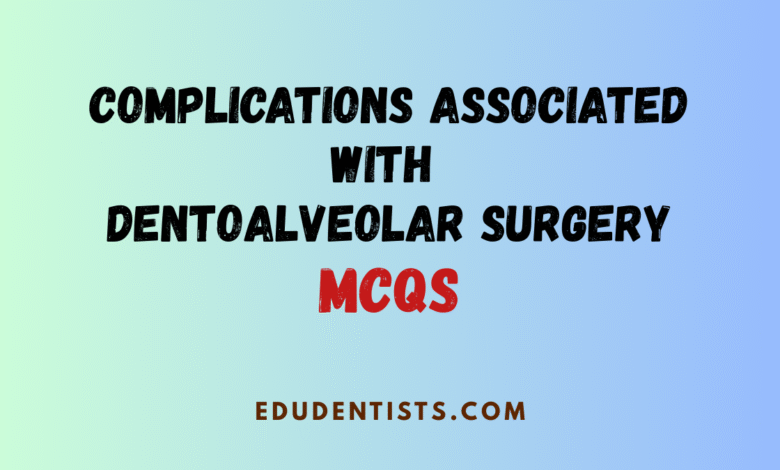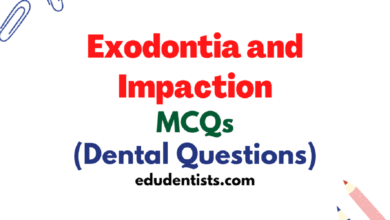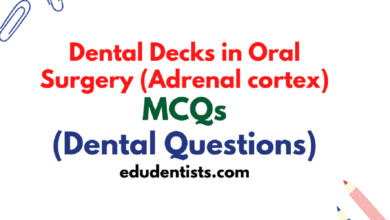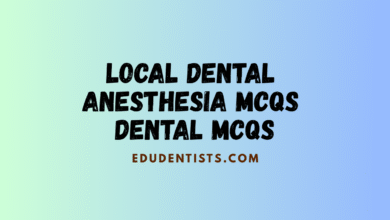Oral and Maxillofacial Surgery MCQs
Dental MCQs – Complications in Dentoalveolar Surgery
Dental MCQs – Complications in Dentoalveolar Surgery

Dental MCQs – Complications in Dentoalveolar Surgery
👍 Complications Associated with Dentoalveolar Surgery
Postoperative Bleeding
- Which of the following best describes “oozing” after dentoalveolar surgery?
A. Profuse bleeding filling the mouth once gauze is removed
B. Minor bleeding that resolves within 36–72 hours with pressure
C. Arterial spurting requiring ligation
D. Hematoma formation - Warfarin therapy is considered safe for simple extractions if INR is:
A. <1.5
B. <2.0
C. <3.0 for 1–3 simple extractions
D. <4.0 - Which anticoagulant regimen usually does not require discontinuation before oral surgery?
A. Aspirin and NSAIDs
B. Warfarin with INR >4
C. Dual anticoagulant therapy with warfarin and clopidogrel
D. Uncontrolled heparin infusion - First-line management for postoperative oozing is:
A. Arterial ligation
B. Firm gauze pressure
C. Electrocautery
D. Hospital admission - A severe case of postoperative arterial bleeding is best managed by:
A. Saline irrigation
B. Application of eugenol
C. Arterial ligation or embolization
D. Observation only
Postoperative Pain
- Typical onset of postoperative pain after extraction occurs:
A. Immediately after surgery
B. 2–4 hours after surgery
C. 6–12 hours after local anesthesia wears off
D. After 72 hours - When does postoperative pain usually peak?
A. Within the first hour
B. 12 hours post-op
C. 24–48 hours post-op
D. 5–7 days post-op - First-line medication for postoperative pain in oral surgery is:
A. Opioids
B. NSAIDs
C. Corticosteroids
D. Antibiotics - Which analgesic combination is used for severe postoperative pain?
A. NSAIDs + corticosteroids
B. Opioids + acetaminophen
C. NSAIDs + antibiotics
D. Corticosteroids + acetaminophen - Which local anesthetic provides long-lasting postoperative pain control?
A. Lidocaine
B. Bupivacaine with epinephrine
C. Articaine
D. Prilocaine
Postoperative Swelling
- Swelling typically starts:
A. Immediately post-op
B. 12–24 hours after surgery
C. 72 hours after surgery
D. 5 days post-op - Swelling usually peaks at:
A. 12 hours
B. 24 hours
C. 48–72 hours
D. 7 days - Postoperative swelling generally resolves within:
A. 2–3 days
B. 1 week
C. 2 weeks
D. 1 month - Which of the following is an effective preventive measure against postoperative swelling?
A. Immediate warm compress
B. Application of ice packs in the first 24 hours
C. Pressure dressing
D. Increased salt intake - Corticosteroids are recommended in swelling management when:
A. Patient has mild discomfort
B. Surgery is extensive (e.g., impacted 3rd molars)
C. Patient refuses analgesics
D. To replace antibiotics
Surgical Site Infection
- Most common site for postoperative infection is:
A. Maxillary anterior teeth
B. Mandibular premolars
C. Mandibular third molars
D. Maxillary canines - Which is NOT a common risk factor for surgical site infection?
A. Smoking
B. Poor oral hygiene
C. High vitamin C intake
D. Older age - Which clinical sign suggests abscess formation rather than cellulitis?
A. Diffuse swelling
B. Warmth
C. Fluctuant swelling with pus discharge
D. Mild trismus - First-line management of cellulitis after extraction is:
A. Incision and drainage
B. Broad-spectrum antibiotics
C. Warm saline rinses only
D. Immediate tooth extraction - If infection spreads severely causing airway risk, the management is:
A. Home antibiotics
B. Emergency airway management and surgical drainage
C. Observation only
D. Antihistamines
Alveolar Osteitis (Dry Socket)
- Peak onset of pain in dry socket occurs:
A. Within 12 hours
B. 1 day
C. 3–5 days post-op
D. 10 days - Which is NOT a feature of alveolar osteitis?
A. Severe throbbing pain
B. Exposed bone in socket
C. Fever and swelling
D. Halitosis - Most important risk factor for dry socket is:
A. Vitamin deficiency
B. Smoking and poor oral hygiene
C. Excessive fluid intake
D. Use of NSAIDs - Primary cause of dry socket is:
A. Infection by streptococcus
B. Dislodgement or failure of blood clot formation
C. Incomplete extraction
D. Antibiotic resistance - Main focus of dry socket management is:
A. Antibiotic therapy
B. Surgical curettage
C. Pain control and medicated dressings
D. Immediate re-extraction
Fractures
- Fractures after extraction are most common in:
A. Children
B. Adolescents
C. Elderly with atrophic mandibles
D. Middle-aged patients - Excessive extraction force may lead to:
A. Alveolar or mandibular fracture
B. Sinus infection
C. Root resorption
D. Malignant change - First imaging modality for suspected mandibular fracture is:
A. Periapical radiograph
B. Panoramic radiograph (OPG)
C. MRI
D. Ultrasound - Conservative treatment of mild alveolar fracture includes:
A. Immediate surgery
B. Dietary modification and immobilization
C. Root resection
D. Extraction of adjacent teeth - Severe mandibular fractures are managed by:
A. Observation
B. Painkillers only
C. Reduction and fixation
D. Topical antibiotics
Root Fractures
- Root fractures are most common in:
A. Maxillary anterior teeth
B. Multirooted posterior teeth
C. Deciduous molars
D. Mandibular canines - Main cause of root fractures is:
A. Caries
B. Excessive force and poor technique
C. Tooth mobility
D. Malocclusion - Which root anatomy increases fracture risk?
A. Straight roots
B. Curved or dilacerated roots
C. Short roots
D. Wide roots - Small asymptomatic root fragments <3 mm may be:
A. Always surgically removed
B. Left in place if no pathology
C. Extracted with apical pressure
D. Removed with forceps - Best instrument for removing retained root tip is:
A. Straight elevator
B. Forceps
C. Root tip pick
D. Curette
Tooth/Root Displacement
- Maxillary root fragments are commonly displaced into:
A. Buccal vestibule
B. Maxillary sinus
C. TMJ space
D. Parotid duct - Mandibular root fragments may be displaced into:
A. Sinus
B. Submandibular space or IAN canal
C. Zygomatic fossa
D. Sublingual gland - Best prevention for root displacement is:
A. Strong apical pressure
B. Periosteal elevator as barrier
C. Use of high-speed drill
D. Antibiotics - If a fragment enters the maxillary sinus, first step is:
A. Radiographic localization
B. Leave it untreated
C. Start corticosteroids only
D. Suture the socket - IAN canal root fragments should be left if:
A. Large and mobile
B. Causing paresthesia
C. Small and asymptomatic
D. Associated with cyst
Oroantral Communication (OAC)
- Most common cause of OAC is extraction of:
A. Mandibular premolars
B. Maxillary posterior teeth
C. Maxillary canines
D. Mandibular incisors - Which maneuver confirms diagnosis of OAC?
A. Percussion test
B. Valsalva maneuver
C. Radiographic bitewing
D. Palpation - Small OAC defects are usually managed by:
A. Spontaneous healing
B. Immediate surgical flap
C. Sinus lift procedure
D. Bone graft - Supportive medication for OAC includes all EXCEPT:
A. Antibiotics
B. Nasal decongestants
C. Antihypertensives
D. Sinus precautions - Persistent OAC with fistula requires:
A. Observation only
B. Surgical closure with layered repair
C. Extraction of adjacent teeth
D. Warm saline rinses
General Complications
- Most common complication after routine extraction is:
A. Oroantral communication
B. Pain and swelling
C. Mandibular fracture
D. Root displacement - Which complication typically occurs latest post-op?
A. Bleeding
B. Pain
C. Infection
D. Swelling - Best overall strategy to minimize complications is:
A. Strong force during extraction
B. Careful case assessment and atraumatic technique
C. Always prescribe antibiotics
D. Use only opioids - Which complication is NOT self-limiting?
A. Alveolar osteitis
B. Minor swelling
C. Oroantral fistula
D. Oozing bleeding - A dental student reviewing complications should focus on:
A. Only pain management
B. Only surgical techniques
C. Etiology, risk factors, prevention, clinical features, and management
D. Only radiographic diagnosis





